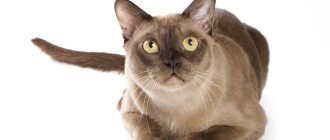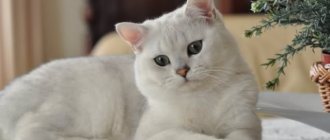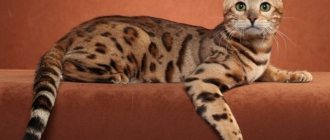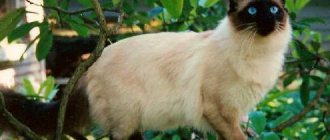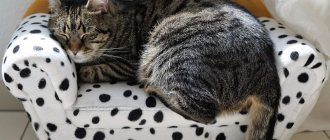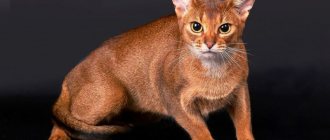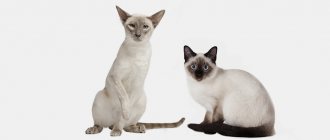Author: Olga
If you have decided to have a gentle, clean pet, then the British Chocolate cat requires special attention. The unique feature of these pets is their devotion to the owner. The cat can find something to do while you are not at home. However, this does not mean that he will not start to get bored. The kitten will be able to entertain not only itself, but also you. The chocolate color will not leave anyone indifferent. The photo serves as excellent proof of this.
[Hide]
British standard
At the present stage, approximately 60 different fur colors have been recorded. A kitten can be blue, black, cream, lilac, red, tortoiseshell, etc. Among the newest and rarest, a cat with chocolate-colored fur occupies a special place. You should know that if stripes or marks of a different color are present, the four-legged furry is discarded.
British chocolate cats are rare. This can be attributed to the fact that a similar color is found only in those animals that have Color Point ancestors with the same coat color in their family. Chocolate British cats have a calm, friendly character. Their short fur is not capable of causing much trouble when cleaning rooms.
How to choose an unusual kitten
A British shorthair of chocolate color or a fold-eared cat of the same color will have to be selected taking into account the characteristics of the breed.
The English cat is characterized by stable health. Just look at the activity of the kittens, their appetite and curiosity (withdrawal will begin to appear a little later).
If a pair of parent cats is incorrectly selected, the Scottish Fold breed sometimes exhibits osteochondrodysplasia, a congenital hereditary disease of the skeleton and osteochondral system.
Kittens with this disease are afraid of sudden movements that can cause pain. Therefore, you should only buy a fold-eared kitten from a nursery or from a breeder with a good reputation.
It is useful to get to know the parents and, if possible, to look at their grown-up children from other litters. As a rule, the same pair consistently produces almost identical offspring.
Looking at them, you can predict the color, size, and even the character of newborn kittens.
A British Shorthair kitten is recommended for people who work a lot and are rarely at home. An hour and a half is enough for them to fully satisfy the need for communication with their pet. And the British also like this daily routine.
Scots are great for homebodies, families with children, and those who enjoy endless cat games. And the brown color always evokes the admiration of guests and a sense of pride among the owners. And the cats themselves are imbued with their own uniqueness and are happy to show off their rich, thick fur the color of fragrant British chocolate.
Genetics of colors
The genetics of the formation of cream color in British cats is closely related to another primary color – red.
- The O gene is responsible for the red color. It has one feature that is unusual for other colors - the gene attaches to the X chromosome, which affects the sex of the future kitten.
- In British female kittens, the defining characteristic is the XX chromosomes, and in boys, the XY chromosomes. It turns out that two O genes can join the chromosomes in a cat, but only one can attach to a cat.
- Each gene is found in a dominant (O) or recessive (o) form.
- In the first case, the combination of OO dictates the obligatory output of red-colored offspring, the OO variant gives the hereditary instruction of a non-red (black) color, and OO extends to tortoiseshell color (in female kittens).
- For boys, the situation is different - one X chromosome and only two options: red and black.
- Cats inherit the color gene from their mother's side. In the case of OO, everything is clear - the animal will definitely be red. The second scenario (oo) is also simple - the British will be black. But in the case of Oo, the baby will take on the dominant red color from the mother cat. Therefore, more red male cats are born than girls.
The second gene, which forms the cream color, is designated D (dilutor, dilutor). In the cat's genetic map, it affects lightening and comes in two forms: dominant D (no lightening) and recessive dd.
At the final point, black turns into brown, chocolate into lilac, cinnamon into fawn, and red into cream. Inheritance of color occurs only from parents to offspring.
It is important! Cream British kittens are only born when both parents have the D gene.
Tortoiseshell colors
Spots of two colors are evenly distributed throughout the body.
rich color (black, chocolate or cinnamon) with red, as well as blue (or purple) with cream.
The colors are distributed equally and look harmonious. The thick coat is short and soft.
The paw pads are pink or black, and the eyes are copper and gold shades. Cream slippers on the paws or short stripes on the nose are possible.
British Chocolate Cream Tortoise
British blue-cream tortoise
British cat lilac-cream tortoiseshell
Photo of a British black tortoiseshell cat
This color occurs only in female cats; due to the peculiarities of genetics, cats are not tortoiseshell.
Fur of four-legged friends
The main color of animals is chocolate color. It has a deep and rich shade. According to the standard, there should be no tabby marks, spots or light-colored hairs at all. The chocolate pigment should be distributed evenly throughout the coat. In this case, the hairs should be soft and short.
Kittens take a long time to acquire a truly chocolate shade. In some cases, the formation process can continue for 15 months. Sometimes the fur can acquire a brown tint, as shown in the photo. However, over time, kittens lose it.
British cats can have fur of different shades of chocolate. Therefore, it will be possible to find pets whose fur coat may be the color of a bitter or milky dessert. A kitten of this color is very popular today. In this, it is not inferior to its purple and blue counterparts.
White based colors
These colors of Scottish breeds are:
Bicolor. Two-color ones, in turn, are presented with the addition of the following colors to white: blue, black, cream, red. The muzzle, abdomen, limbs and thighs remain entirely light. The eyes are the color of gold or sky. Such tartans can have eyes of different colors.
Wang. Almost all the fur is white, only the tail and a couple of markings on the head are colored.
Harlequin. The edge is mostly white, only a fifth of the surface is colored.
Ticking. All fur with distinct ticking. The eyes are all shades of gold; those with a silver color are greenish.
How to determine the color of a British cat
The color of a British cat is determined visually, and the final decision is made only upon reaching the age of 1–1.5 years - until this time, the coat may fade and change. An expert can give the most accurate assessment. A specialist must study the main color, the presence of rejection characteristics, pattern and shading (if any) - all this can really be done by eye, knowing the requirements for the numerous colors of British cats.
There is such a procedure as conducting a genetic test (using any biological material, most often blood). It also relates to the determination of color, but not of an adult animal, but of its future offspring. Based on the results of the analysis, it is possible to determine the carriage of certain genes, which will allow you to select a partner to obtain the desired color. So, for example, any British dog can get a lilac coat color, but only if both have a recessive form of the d gene. Such a test is of great importance for breeding work.
British cats are not only the familiar gray plush pets, this breed boasts a huge list of possible colors. Various monochromatic (solid) variants can be called classic, and active breeding work has made it possible to create the most incredible combinations, in particular, tortoiseshell multi-color colors with a tabby pattern.
Fold English cats and their colors
The second line of cats, which is mistakenly attributed to the British breed, differs only in one feature - the shape of the ears (the tips are curved forward).
The history of the fold-eared breed began in 1961, when an animal with a characteristic mutation was discovered in central Scotland. The cat Susie gave birth to two kittens who received a genetic defect from their mother.
Initially, chocolate fold cats were called British, but later they were separated into a separate group. In 1971, felinologists banned the breed due to health problems caused by the fold gene.
The breed was saved by breeders from the USA. They carried out a number of interbreedings with British, American Shorthairs, Burmese, Siamese and Exotics. The result was a beautiful cat, vaguely similar to its English ancestors, but smaller in size and with the main distinguishing feature - lop ears.
The genetic nature of the chocolate color in the British and Scottish Folds is the same (brown-chestnut color with a dense undercoat). This color is as rare in fold-eared cats as in the main breed, which is why it is highly valued among cat lovers.
Appearance Options
The Chocolate Briton has a strong build and a wide chest. Cats usually have short legs and a round head. It should be noted that the cat has fairly wide cheekbones. A kitten or cat's ears are straight. They are located quite widely.
The cat has eyes that are dark orange or copper in color. In this case, the more saturated the shade, the better. Purebred kittens have dark brown fur.
For a long period of time, chocolate-colored cats could only be found among representatives of oriental breeds. We are talking about Siamese, Oriental, Burmese cats. The British cat got its chocolate shade thanks to Persian Colorpoints of the corresponding color.
An interesting thing is that chocolate kittens have become more popular over time compared to their counterparts, thanks to which they acquire a beautiful shade.
Solid colors
The color should be solid and uniform, without variegated hairs, spots, shades or patterns.
The fur of such cats is short and thick, and soft to the touch, like plush.
British black cat
Blue British kitten
Photo of a British chocolate cat
Lilac color of British cats
- Red (red, golden)
Photo of a red British cat
- Cream (peach, beige)
Photo of a cream British cat
Photo of a white British cat
Eye color is bright copper or orange, and white British people can have blue or even multi-colored eyes.
White British kitten with blue eyes
Odd-eyed Briton
The very rare solid color cinnamon was developed quite recently.
It is much lighter than chocolate and is called the color of ground cinnamon.
Chocolate Britons have a nose color that is slightly darker than the coat or matches its color, while Cinnamon, on the contrary, has a pinkish-brown nose that stands out against the darker coat.
British cat cinnamon
Cats of the fawn color (also called the color of a young fawn) have fur of a warm light beige shade, and the pads of their paws and nose are a delicate pinkish color.
The eye colors of cinnamons and fauns range from golden to rich copper.
British fawn cat
Tabby
The Tabby (Tabby) color allows cats to have patterns of different directions, sometimes the coat can even be ticked or marbled. The main signs of a Tabby are the letter M located on the animal’s forehead (scarab sign), dark stripes near the eyes and on the cheeks, and rings on the neck and chest.
The brindle (mackerel, striped) color option is considered the most common among tabbies. A line of the main coat color runs along the entire spine. From the name it is clear that the pattern is made up of dark stripes. A clear and separated pattern is a requirement made by specialists. If this rule is violated, the animal is rejected. The eyes are bright - red and copper.
The British spotted tabby cat is distinguished from others by horizontal dark lines extending from the eyes. There are also stripes on the animal’s cheeks. A dark broken line runs along the spine, and on the sides there are a large number of dark spots and dots. The tip of the tail is dark, with striped rings running along its entire length.
Spotted tabby color
The British merle tabby color is considered classic. It is characterized by light silvery sides with dark spots or stripes. The pattern looks very impressive, since it is not interrupted or intersected anywhere. On the back of the head there is a pattern in the shape of a butterfly, and the letter M, standard for the color, is located lower than usual, closer to the nose. Eye color is copper with smoky rims. The British Marbled cat looks expensive and elegant.
We suggest you familiarize yourself with: List of horse names, how to name a stallion
Interesting! Small kittens may have an undivided merle color. When they reach the age of 2 months, the pattern becomes clear.
Torby (tobry) is a color that combines two color varieties: patterned and tortoiseshell tabby. A spotted, marbled or striped pattern arrangement is allowed. The standard assumes that the British tortoiseshell tabby color has rings on the neck, stripes on the legs, the letter M on the forehead, which is characteristic of all tabbies, and rings along the entire length of the tail. In kittens, identifying this type of pattern is problematic, but as they grow older, at about 12 months, the lines become clearer.
For many, this coloring of a cat looks like it is uniform, but it is not. The color is original, since the top part of the coat looks like a light dusting, and this shade is identical to the color of the lower part of the undercoat. Most often these colors are blue, black and chocolate, but others are also allowed.
Chinchilla
The main color types are described below.
Silver
For this color, white wool is the basis. Each hair (not in the undercoat) has black tipping, i.e., an eighth of it is black. This is especially pronounced on the sides, tail and back. The coat looks covered with a dark coating. Always black paw pads, nose rim and eye contour.
Interesting! The silver chinchilla is the most common option among cats of this color.
This color is characterized by a bright apricot thick undercoat. The tipping of the main coat is black or blue. The color of the nose, eye rims and paw pads corresponds to the shade of the tips of the coat. There are no stripes, spots or any other inclusions. The coloring is uniform, darker on the sides, back and tail.
The fur is darker than silver. The tipping is painted on a third of the entire length. All other characteristics are the same, but dark fur is also visible between the tips of the fingers.
Interesting! In addition to the British, Scottish, Persian and Burmese cats also wear the chinchilla color.
British golden chinchilla
British character
The British cat and cat are distinguished by their affectionate nature. They become quite attached to their owner. However, they are able to easily endure separations. The main thing is that they are not too long. By temperament, chocolate-colored pets are calm and balanced.
They can only show character when eating. In this regard, they are quite demanding. The cat is able to insist that food be served on time. Therefore, it is important to immediately determine the feeding regimen and follow it.
The video clearly shows what they are like - British chocolate cats.
Description of the Yorkie Chocolate Cat
The appearance of the chocolate breed is almost identical to the Persian cat. The coat is of medium length, soft, shiny and silky, quite thick. The eyes are of medium size, oval, slightly slanted, the color of the eyes of kittens is blue, with age they become brown with an amber tint.
The fur of these cats is medium length, silky and thick.
The breed itself is quite large, the head is medium in size, the limbs are slender, the tail is medium or long, very fluffy. The breed's ears are wide, slightly pointed, and large. The coat color is lilac, chocolate or chocolate lilac with a little white. The weight of an adult is from 8 to 10 kg.
The chocolate cat is very friendly, affectionate, sociable, and loves attention and games. But there are also pets that don’t like increased attention: if a cat wants to communicate, it will come up to you and sit next to you. He behaves friendly with other animals and gets along easily with cats and even dogs. The Yorkie breed loves to hunt, so if you have tame mice, hamsters or guinea pigs in your house, it is better to keep them away from the cat.
Such cats endure loneliness very painfully: they very quickly get used to their owner and want to receive their portion of love and attention. They treat strangers with distrust, observing them from the outside. If the cat understands that there is no danger, then it will come closer to get to know each other and communicate. The breed adapts well to living in an apartment or private house.
Where to buy kittens?
We all have a natural desire to save money, and unscrupulous people often take advantage of this. Buying a purebred animal is no exception to the rule; today such deceptions are not uncommon.
A purebred kitten cannot be cheap; if you are offered a show-class kitten, then you should immediately suspect something is wrong. Either they openly want to deceive you, or you are faced with an inexperienced cat lover who doesn’t even know all the ins and outs about the breed. In this case, immediately refuse the purchase.
Do not take kittens only based on an advertisement on the Internet; they can sell you a British kitten without documents. How much such a kitten costs is not even worth finding out, because no one can guarantee that both parents are purebred and have no defects in their pedigree.
The best purchasing option would be to contact a specialized nursery, where they will not only sell you a purebred animal, but will also give you detailed advice on raising and feeding a kitten.
Upbringing
If you are attracted to kittens of a given breed and color, and after looking at numerous photos and videos, you decide to get a pet, you should understand that you will practically become a parent for it. Chocolate fluffies are no different from other little four-legged friends. They love to be active, playful, and want to receive affection and praise from their owners.
Kittens are very curious creatures. In their quest to know everything, they are capable of crawling around the entire house. A kitten can charm quite easily, as evidenced by various photos. Spontaneity and sweet habits and habits help him in this. However, from a young age he must be taught discipline. This will help get rid of numerous problems and protect your pet from all kinds of injuries.
Kittens must understand immediately what can and cannot be done. Hitting and swinging at the fluffy is not recommended. You should stop pranks with your voice. This will help not embitter the baby. If you approach your upbringing wisely, kittens will not put out their claws, bite, crawl on clothes or damage furniture. Don’t forget that both cats and cats of popular colors need affection and praise.
Maintenance and care
If you decide to get yourself a Chocolate Yorkie cat, you should be prepared for the fact that his long hair can leave marks on your carpets and sofas.
Yorkie Chocolate cats are unpretentious in their care. Their long coat requires periodic brushing to prevent clumps from forming. If clumps of fur have already formed, then try to carefully unwind them or use scissors and cut off the clump - the hair will quickly grow back in this place on its own. To avoid this situation, buy a soft brush and brush your pet's fur in the evening while watching your favorite shows.
This cat needs to be bathed as needed. Periodically wipe your eyes with a swab soaked in warm water and remove wax from your ears. The cat copes with care on its own, and at the same time it really likes when its owners look after it. The main thing for them is that they feel attention and love for themselves - this is the only way Yorkies can be happy.
How many breeds are there?
There are not as many cat breeds as there are dog breeds, but there are still plenty to choose from. Even an avid cat lover cannot give the exact figure, because there are many associations and clubs in the world involved in the classification and exhibition of cat breeds. And their accepted breed standards may differ from each other, and if in one association a breed is considered recognized, then in another it will be only a branch of another.
On average, today there are over a hundred cat breeds, and together with the varieties there will be all seven hundred. Among them there are both large and small breeds, as well as with different colors and coats.
The British breed is recognized as one of the most popular in the world, and how much a kitten of the British species costs depends on a number of factors, which we will discuss below.
Types of merle colors among the British
This color belongs to a group of colors called tabby (from the name of the striped fabric brought to England from Baghdad). The peculiarity of this pattern is the continuity of lines and the uniqueness of the pattern for each individual. Thanks to the efforts of felinologists, today the British marble coat is represented by many varieties.
Black marble
The main background of the coat is dark gray, the stripes have a pronounced black tint. There is a black outline around the eyes and nose, the color of the eyes is brown-orange.
British black marble shades are highly prized by animal lovers.
Black marble on silver
Charcoal stripes and spirals are symmetrically arranged on a silver background. There are dark spots near the eyes and the red-brown nose.
Black marble on silver - exquisite colors of British cats
Black marble on gold
The main color of the coat is copper-golden, the stripes have a black or dark brown tint. The eyes are most often green or yellow.
The British with the “black marble on gold” color look very presentable
Lilac marble
The silver fur coat is decorated with patterns of lavender or peach undertones. There is also a lavender rim around the nose and eyes. The iris is yellow or pale brown.
British cats with a lilac-marble hue are quite unusual
Tortoise marble
The main background can be silver-red or silver-brown, while the spots and patterns remain black or dark brown. The eyes are often yellow or greenish. The color is characteristic only of females; in rare cases it is found among males. Cats with this color cannot have offspring due to genetic characteristics.
Tortoiseshell marble involves adding reddish shades to the main color scheme
Chocolate marble
The fur coat is the color of milk chocolate, the pattern is dark brown. The eyes and nose are outlined with thick chocolate eyeliner. The color of the iris is from yellow to golden brown.
Chocolate Marble is a common color option among the British.
Bicolor
The main color with spots is diluted with white inserts on the paws, chest and belly. Eyes can be yellow, brown or green.
Bicolor color is also found among British harlequins.
Red marble
The light red fur of the main background is decorated with spots and streaks of a rich red hue. The eyes are orange, brownish-golden.
Red merle is a red British breed with merle patterns on their coats.
Red marble on silver
It is distinguished by a silvery tone of the main background, the spots have a light red color. The fur around the eyes is white, the nose is pink. The eyes are yellow or golden.
Red marble on silver - a spectacular coat color for the British
Cream marble
The main background has a shade of creme brulee, and the spots tend to be peach. There are white hairs around the eyes and a pink nose. Eyes yellow or gold.
Cream marble is a very delicate shade of the fur of British cats.
Blue marble
Silver coat with smoky gray stripes and spots, dark gray lining around the nose. The eyes are not circled and have a brown-golden tint.
The British in the shade of “blue marble” look noble
Where is the price higher?
If you ask how much a British kitten costs in Moscow or another metropolis, and compare the prices with the cost of kittens in the regions, you will be unpleasantly surprised. Pedigree animals in the capital will cost more than kittens from the regions.
The reason for this is clear - everything is more expensive in Moscow. But another question arises: is it worth buying kittens from the regions or paying more, but buying in the capital? And here not everything is clear.
In big cities, prices may be higher, but there is also more choice. In addition, you can find breeders who have been breeding this breed for more than one year and regularly participate in exhibitions. This means that you will be able to purchase not just a kitten from breeding parents, but also, possibly, champions of your breed. But you need to be prepared for the high cost of the animal.
In small regions there is another extreme - there are practically no professional breeders, and there is no need to talk about participation in exhibitions.
Breeding
Many breeders take the sale of cats for breeding very seriously, and therefore the prices for them are much higher than those individuals that are sold only as pets. That is, for castration and sterilization. British merle dogs cost on average 20-25 thousand rubles for sterilization, and several times more expensive for breeding. Depending on the reputation and popularity of the nursery, prices can reach up to 100 thousand rubles, but it will be a real, elite and purebred kitten.
If you want to purchase a marble kitten for further mating, then you should understand that it must have all the documents and pedigree, otherwise it will be incredibly difficult to find a worthy purebred pair.
And it is also worth understanding that for breeding British marbled cats, a fairly large room for keeping them is recommended. Before you decide to breed British marble cats, it is recommended that you carefully weigh the pros and cons. You should only purchase a kitten from a trusted nursery with a good reputation.
You can give a marble boy or girl a very original name that will appeal to all household members in the house. Even if the animal was not purchased for mating, it will delight the whole family for many years, because on average the British live 17 years.
About British cats, watch the following video:
Origin story
The breed appeared in Great Britain in the 19th century. About 10 years were spent on selection. The color was obtained by crossing recessive forms of British cats of chocolate and blue shades. According to statistics, only a quarter of pets are born with a similar shade. About 30 years ago, felinologists officially accepted the color.
The belief that the color was created by crossing a Scottish fold cat and a marbled cat is incorrect. The result of this will be the birth of kittens with disorders at the genetic level.
The British Lilac cat is not a separate breed, but belongs to British cats with short hair; the main difference with other representatives lies in the shade of the coat.
There is no breed of British Fold. There are only short/long-haired British and lop-eared/straight-haired Scots.
The history of the appearance of chocolate color among the British
In the middle of the 19th century, Great Britain was recognized as the center of world felinology.
Along with warriors and traders, exotic cats migrated to the kingdom, adapted to the new climate and gradually formed a stable aboriginal population. England, of course, has something to be proud of in the development of cat traditions. The first official exhibition of four-legged pets took place here. In 1871, the Crystal Palace in London's Hyde Park was allocated for this event. This is where the history of public shows and competitions among cats of different breeds began.
At first, the British were bred with a gray-blue color, which later became established in the breed and was recognized as the standard for it. Later, mass selection occurred, resulting in about 250 color combinations.
They, in turn, were divided into 6 groups:
- solid;
- tabby;
- smoky;
- tortoiseshells;
- two-color;
- color-point.
British chocolate kittens are part of the solid color group. There is an opinion that this coat color appeared as a side effect after mating with Persians, Siamese, Burmese and Oriental cats.
Breeders sought to obtain an acromelanic mask, and with it the chocolate color came to the breed. Later, all that remains is to strengthen it, achieve uniformity and consolidate it in the offspring.
It is known that the first “chocolates” appeared at cat shows in the mid-80s, and only a few nurseries in the world dealt with them. Later, the list expanded, but due to difficulties in breeding and high risks, the chocolate British never entered the mainstream. And now they are considered rare species of cats even in their homeland.
What to feed
Food from the family table is not suitable for your pet. There is not much information on what to feed small British kittens. Contrary to popular belief, cats should not be fed fish 7 times a week. A photo of a British kitten by month shows the growth and external changes of the baby.
There are also age restrictions on the baby menu. What is the best way to feed a British kitten:
- lean boiled meats, exclude pork;
- cottage cheese, kefir and sour cream;
- boiled vegetables;
- cereals;
- boiled fish: no more than once a week.
What to feed 1st month
The kitten will be satisfied with its mother's milk for up to a month. At the beginning of the 4th week, the cat’s food dishes should be placed next to the cat’s bed. Babies will be attracted by the smell of food, then you can gradually introduce complementary foods: once a day. They give natural products or wet specialized food for kittens. The crumbs easily cope with food, bringing the food to 3-5 rubles per day. Growth and weight gain are monitored simultaneously: the kitten’s weight should correspond to the age norm. At 6 weeks the animal usually stops drinking cat milk.
What to feed 2nd month
At home, conditions of detention are not always followed, but you need to know what to feed a British kitten at 2 months. Babies at 2 months finally refuse mother's milk. Supplementary feeding is carried out up to 5-8 r. per day. Factory canned food is diluted with small portions of dry food
What to feed the 3rd month
A British kitten has been confidently eating supplementary food since three months. It is necessary to weigh the baby and observe the excess weight gain. Follow the recommendations on what to feed a British breed kitten at 3 months and monitor the functioning of the gastrointestinal tract. There is no need to give milk to the cubs at this age.
What to feed the 4th month
At 4 months, complementary feeding is reduced to 5 times a day. Monitor the replenishment of clean water in the bowl: the baby must drink. You can contact a specialist to create a rational menu.
The baby's diet should include vitamins and minerals, calcium for growth and strengthening of bones. Industrial feeds take into account the ratio of nutrients and the age of the kitten. British kitten 4 months old in the photo.
Royal canin food is known to the British. What food is best for British kittens: one that will help their little bodies grow and develop, maintain the shine of their coats and help with oral hygiene. Dry foods are formulated to optimize teething for pets. What can you feed a British kitten from commercial food: the Royal Canin company produces food for kittens containing a vitamin-mineral complex; they also offer a cat's milk replacer.
What to look for when choosing a kitten
If you have the time, energy, opportunity, and patience to deal with such a pet, feel free to get such a pet. When you see a chocolate kitten, it seems so cute that you want to pick it up and stroke it, cuddle it... But you and I already know that cats of this breed do not like and will not appreciate such manifestations of your feelings. So - if you need an affectionate kitten who sits patiently in your arms - give up this proud one. Otherwise, these kittens are very friendly, calm and balanced. They are not very picky and picky when it comes to food - they will eat what you are accustomed to.
As for discipline: the kitten must immediately be made to understand what is good and what is bad. You can prevent his pranks, but not with beating, but with a stern voice. If you raise a kitten correctly, you will not have problems with damaged furniture and other troubles in the future.
In Europe, it is believed that the best age to purchase a kitten is 3-4 months. At this age he is already independent, and the first vaccinations have already been done.
He will get used to new living conditions faster than a small kitten
The most important thing is to determine whether the kitten is healthy. You can judge this by appearance: a healthy pet is well-fed, but not pot-bellied; if the ribs stick out, this is a clear sign of exhaustion
Examine the fur carefully: healthy cats have even, smooth, shiny hair. There should be no damage or bald spots on the skin.
A healthy cat's eyes are clear, and nasal discharge indicates respiratory disease. You should see pink gums and even baby teeth when you look into the kitten's mouth. Be sure to look at his gait: he should be active, mobile and curious. Usually, kittens of this breed are easy to train, but at first you need to be patient and affectionate. After all, it has long been known: the more love and affection we give, the more the animal will give us back in return! Good luck.
On video: how to wash a British cat.
